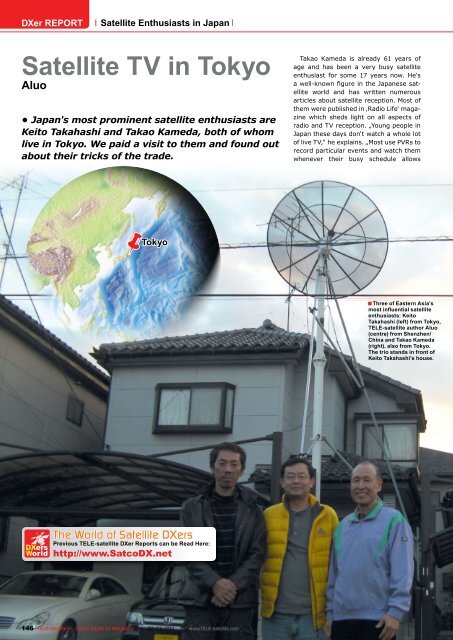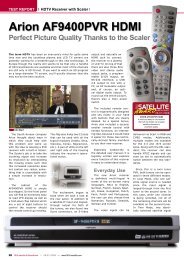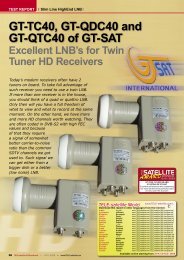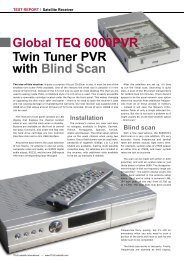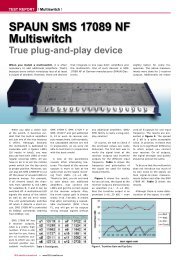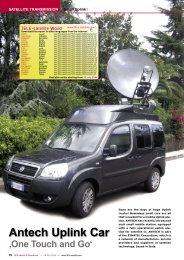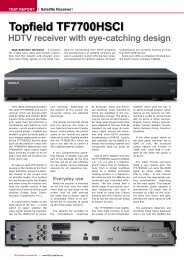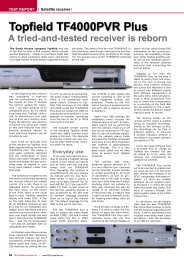Satellite TV in Tokyo Aluo - TELE-satellite International Magazine
Satellite TV in Tokyo Aluo - TELE-satellite International Magazine
Satellite TV in Tokyo Aluo - TELE-satellite International Magazine
Create successful ePaper yourself
Turn your PDF publications into a flip-book with our unique Google optimized e-Paper software.
DXer REPORT<br />
k<br />
DXers<br />
World<br />
<strong>Satellite</strong> Enthusiasts <strong>in</strong> Japan<br />
<strong>Satellite</strong> <strong>TV</strong> <strong>in</strong> <strong>Tokyo</strong><br />
<strong>Aluo</strong><br />
• Japan's most prom<strong>in</strong>ent <strong>satellite</strong> enthusiasts are<br />
Keito Takahashi and Takao Kameda, both of whom<br />
live <strong>in</strong> <strong>Tokyo</strong>. We paid a visit to them and found out<br />
about their tricks of the trade.<br />
ë<br />
<strong>Tokyo</strong><br />
The World of <strong>Satellite</strong> DXers<br />
Previous <strong>TELE</strong>-<strong>satellite</strong> DXer Reports can be Read Here:<br />
http://www.SatcoDX.net<br />
146 <strong>TELE</strong>-<strong>satellite</strong> — Global Digital <strong>TV</strong> Magaz<strong>in</strong>e — 02-03/2011 — www.<strong>TELE</strong>-<strong>satellite</strong>.com<br />
Takao Kameda is already 61 years of<br />
age and has been a very busy <strong>satellite</strong><br />
enthusiast for some 17 years now. He‘s<br />
a well-known figure <strong>in</strong> the Japanese <strong>satellite</strong><br />
world and has written numerous<br />
articles about <strong>satellite</strong> reception. Most of<br />
them were published <strong>in</strong> ‚Radio Life‘ magaz<strong>in</strong>e<br />
which sheds light on all aspects of<br />
radio and <strong>TV</strong> reception. „Young people <strong>in</strong><br />
Japan these days don‘t watch a whole lot<br />
of live <strong>TV</strong>,“ he expla<strong>in</strong>s. „Most use PVRs to<br />
record particular events and watch them<br />
whenever their busy schedule allows<br />
■<br />
Three of Eastern Asia’s<br />
most <strong>in</strong>fluential <strong>satellite</strong><br />
enthusiasts: Keito<br />
Takahashi (left) from <strong>Tokyo</strong>,<br />
<strong>TELE</strong>-<strong>satellite</strong> author <strong>Aluo</strong><br />
(centre) from Shenzhen/<br />
Ch<strong>in</strong>a and Takao Kameda<br />
(right), also from <strong>Tokyo</strong>.<br />
The trio stands <strong>in</strong> front of<br />
Keito Takahashi’s house.
■<br />
Keito Takahashi has<br />
mounted his rotatable C<br />
band mesh antenna on a<br />
professional pole with a<br />
height of 7 metres.<br />
148 <strong>TELE</strong>-<strong>satellite</strong> — Global Digital <strong>TV</strong> Magaz<strong>in</strong>e — 02-03/2011 — www.<strong>TELE</strong>-<strong>satellite</strong>.com<br />
some time to be spent <strong>in</strong> front of the<br />
<strong>TV</strong>.“ Unfortunately, the entire magic of<br />
receiv<strong>in</strong>g foreign <strong>satellite</strong> channels from<br />
far-away corners of the world is lost <strong>in</strong><br />
the process. „When ASIASAT 1 started<br />
we all got very excited, as channels from<br />
that position were transmitted <strong>in</strong> NTSC,“<br />
Takao Kameda remembers. NTSC was<br />
the analog colour system used <strong>in</strong> Japan,<br />
so DXers were able to watch channels<br />
from ASIASAT 1 with their exist<strong>in</strong>g <strong>TV</strong>.<br />
Over the course of so many years Takao<br />
Kameda has steadily enlarged his collection<br />
of <strong>satellite</strong> receivers us<strong>in</strong>g all sorts<br />
of CA systems. Right now he is hav<strong>in</strong>g<br />
an <strong>in</strong>-depth look at the iCool G2 DVB-S2<br />
receiver.<br />
Keito Takahashi is a similarly committed<br />
<strong>satellite</strong> enthusiast. He even speaks<br />
Ch<strong>in</strong>ese and is a regular viewer of the<br />
Ch<strong>in</strong>ese <strong>satellite</strong> channels by CC<strong>TV</strong>. He<br />
jo<strong>in</strong>ed the <strong>satellite</strong> community more than<br />
ten years ago when he bought his first<br />
<strong>satellite</strong> antenna: It was a 3-metre KTI<br />
mesh antenna imported from the USA.<br />
Today he operates a 2.4m mesh antenna<br />
for the C band and a smaller 1.2m dish<br />
for the Ku band. Keito Takahashi is a true<br />
celebrity and a popular <strong>in</strong>terview partner<br />
for Japanese <strong>TV</strong> stations and newspapers<br />
when it comes to experience and expertise<br />
<strong>in</strong> the <strong>satellite</strong> field. He also loves<br />
Ch<strong>in</strong>a and even sent his son over to Ch<strong>in</strong>a<br />
to learn the language. „I watch Ch<strong>in</strong>ese<br />
<strong>TV</strong> and learn the language from watch<strong>in</strong>g<br />
and listen<strong>in</strong>g.“ Another worthwhile reason<br />
for becom<strong>in</strong>g a <strong>satellite</strong> enthusiast!<br />
■<br />
Hardly noticeable<br />
from outside: Keito<br />
Takahashi’s two<br />
antennas <strong>in</strong> <strong>Tokyo</strong> (C<br />
band <strong>in</strong> front, Ku band<br />
<strong>in</strong> the back).


